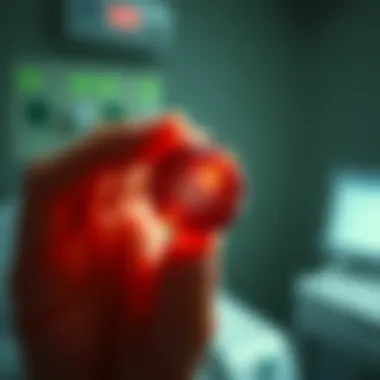Causes of Non-Photoreactive Hypertension Explained


Intro
Understanding the mechanics behind non-photoreactive hypertension (NPH) is essential, albeit often neglected in mainstream discussions. This condition stands apart from the familiar presentations of high blood pressure, primarily because it doesn't exhibit the expected response to light or certain stimuli. To put it plainly, while you might be accustomed to seeing how blood pressure can fluctuate in response to commonly assessed triggers, NPH manages to sidestep these cues.
The intricacies of NPH are woven together by several threads, including genetic predispositions, environmental stressors, and even previously unnoticed health conditions. Delving into these factors not only broadens our understanding but might also uncover potential pathways for innovative clinical interventions. This article seeks to demystify NPH, breaking it down into digestible parts while addressing the significance of recognizing the condition in clinical settings.
By the end of our exploration, readers should be well-equipped to understand the broader narratives surrounding NPH, allowing them to appreciate its potential impacts on patient care and management strategies. Let’s begin this enlightening journey by clarifying some of the key concepts and terminology surrounding non-photoreactive hypertension.
Key Concepts and Terminology
Definition of Key Terms
- Non-Photoreactive Hypertension (NPH): A form of high blood pressure that does not respond typically to light or certain environmental stimuli, making it a more complex condition to diagnose and treat.
- Blood Pressure Regulation: The physiological processes that govern the maintenance of blood pressure within the optimal range, often affected by a variety of factors.
- Physiological Mechanisms: The biological processes and reactions in the body that contribute to the development and maintenance of hypertension.
- Comorbidities: Co-existing medical conditions that may complicate or exacerbate the symptoms of NPH.
Concepts Explored in the Article
Discussion will pivot around key factors contributing to NPH, including genetic influences—how inherited traits might predispose individuals to this condition. Moreover, this article will delve into environmental elements, such as lifestyle choices and socio-economic factors that may play a crucial role.
In tandem with these influences, we will also consider the underlying physiological mechanisms and the complex interplay of various comorbidities that can pose challenges in the management of non-photoreactive hypertension. With a clearer foundation laid out, we can better explore the nuances of NPH.
Findings and Discussion
Main Findings
Here, we will summarize pivotal insights into what causes non-photoreactive hypertension and how they interconnect. Research has shown that genetic factors can increase susceptibility to NPH. For instance, various studies have indicated that specific gene mutations may affect blood vessel elasticity and responsiveness, ultimately leading to high blood pressure that doesn't respond to routine stimuli. Furthermore, lifestyle factors—such as diet, physical activity, and stress—come into play, complicating the landscape.
Potential Areas for Future Research
Future investigations may focus on several under-explored areas:
- The role of emerging technology in diagnosing NPH more accurately.
- Longitudinal studies examining how the modulation of environmental factors can alter the course of NPH.
- The multifaceted relationship between NPH and mental health issues such as anxiety and depression, warranting a biopsychosocial approach to treatment.
"Understanding non-photoreactive hypertension requires a nuanced appreciation of its multifactorial origins. Failing to recognize NPH might lead to oversights in effective patient care."
As we continue our examination, we will delve deeper into specific genetic and environmental factors that influence NPH and highlight their implications for targeted interventions in patient care.
Understanding Non-Photoreactive Hypertension
Non-photoreactive hypertension (NPH) is increasingly coming into focus within medical discussions, yet it remains shrouded in complexity for many healthcare professionals and scholars alike. This form of hypertension stands apart from the more widely recognized reactive types, as it does not exhibit typical fluctuations in response to stimuli such as light exposure or stress. Understanding NPH is vital for a multitude of reasons, not least because it lays the foundation for more tailored treatment options and deeper insight into patient management strategies.
Definition of NPH
At its core, NPH is defined as a sustained elevation in blood pressure that remains constant across different environmental conditions and stimuli. Unlike its photoreactive counterpart, NPH does not respond dynamically to variations in light or emotional state, making it a challenging condition to diagnose and treat. In simple terms, if you were to compare NPH to a stubborn mule, it just doesn’t budge under pressure or change with external influences. This consistency may suggest underlying physiological mechanisms that warrant further investigation.
Significance in Medical Research
Research into non-photoreactive hypertension continues to reveal essential insights that could dramatically impact clinical practice. The significance of studying NPH lies in its potential links to various health conditions, including metabolic syndromes and cardiovascular diseases. Understanding these connections can help medical professionals to better predict patient outcomes and identify high-risk groups.
Furthermore, by zoning in on NPH, researchers tap into a reservoir of data that can offer clues about genetic vulnerabilities and environmental triggers. For instance, uncovering specific genetic markers related to NPH could pave the way for personalized medicine approaches, enabling more effective treatment protocols.
"Recognizing NPH is crucial for patient care and better health outcomes. It moves beyond the surface, diving deep into the life-altering implications that come with managing chronic hypertension."
In essence, delving into NPH not only enhances our grasp of hypertension as a whole but also opens doors for groundbreaking treatment strategies, highlighting its undeniable significance within the ambit of medical research.
Genetic Influences on NPH
Genetic factors play a pivotal role in the development and regulation of non-photoreactive hypertension (NPH). As we explore this topic, it is essential to acknowledge how hereditary traits and genetic markers can influence blood pressure responses. By understanding these genetic influences, researchers and healthcare professionals can develop better prevention strategies and treatment options for patients afflicted by NPH. The knowledge that certain genetic predispositions exist compels us to consider genetic testing and family histories during evaluations for hypertension. Thus, this area not only broadens the field of hypertension studies but also holds significant implications for personalized medicine.
Hereditary Factors
Hereditary factors contribute to a person's susceptibility to NPH. This connection can often be traced back over generations, where family histories may reveal patterns of hypertension. For instance, individuals whose parents suffered from hypertension may carry genetic variants that predispose them to similar health challenges. Some studies suggest that familial aggregation is more than just coincidence; it indicates that specific genes involved in blood pressure control may be passed down from one generation to the next.
- Familial Patterns: Identifying a strong family history of hypertension can alert physicians to investigate hereditary factors in their patients. Common hereditary conditions that intertwine with NPH might include metabolic disorders, which affect how blood vessels respond to various stimuli.
In some cases, alterations in genes responsible for electrolyte balance and vascular tone regulation, such as the angiotensinogen gene, have been linked to hypertension. The contribution of genetics is thus clear, as these inherited variations may dictate how effectively an individual can respond to lifestyle choices or medications designed to manage hypertension.
Genetic Markers Associated with Hypertension
Numerous genetic markers have been identified as playing a role in the modulation of hypertension. Understanding these markers offers crucial insights into personalized health strategies. For instance, single nucleotide polymorphisms (SNPs) have been significant in pinpointing individuals more prone to developing NPH.
- Common Genetic Markers:


- AGT (Angiotensinogen): Variants in this gene have been shown to elevate plasma angiotensinogen levels, which in turn increases blood pressure.
- ACE (Angiotensin-Converting Enzyme): The insertion/deletion polymorphism in this gene affects how angiotensin converts into its active form, influencing vascular resistance and blood volume.
The heterogeneity of hypertension means that genetic research is vital to comprehending the multifaceted causes of NPH. Furthermore, integration of genetic data with clinical observations can enhance the accuracy of disease predictions, ultimately aiding in the prevention and management of not only non-photoreactive hypertension but also its associated complications.
"Genetic markers hold the key to understanding individual risks and tailoring therapeutic interventions in hypertension."
In summary, the intersection of genetic influences with non-photoreactive hypertension is of utmost importance. The hereditary factors combined with significant genetic markers illuminate the unseen vulnerabilities many face regarding hypertension, underscoring the need for further exploration in this arena. These insights will hopefully pave the way for new avenues in gene-targeted therapies and predictive medicine.
Environmental Factors Contributing to NPH
The significance of environmental factors in the context of non-photoreactive hypertension (NPH) cannot be overstated. While genetic predispositions lay the foundation for many conditions, it's often these external influences that sculpt the trajectory of hypertension. Factors such as lifestyle choices and socioeconomic status distinctly impact the prevalence and management of NPH. This deep dive into environmental aspects serves as essential knowledge for students, researchers, educators, and professionals who wish to grasp a more holistic understanding of NPH.
Lifestyle and Behavioral Causes
Physical Inactivity
Physical inactivity stands as a major player in the rise of non-photoreactive hypertension. Modern lifestyles, often dominated by sedentary jobs and leisure activities centered around screens, diminish the natural mechanisms that regulate blood pressure. A unique characteristic of physical inactivity is its ubiquitous presence across nearly all age groups and demographics, making it an ever-relevant issue in today's society.
Why It Matters: In this article, understanding physical inactivity is crucial, as it illuminates how lacking even moderate levels of exercise can negatively affect cardiovascular health. Individuals who don’t engage in regular physical activity are prone to obesity, elevated blood sugar levels, and poor heart function, all of which contribute to hypertension. As noted by the American Heart Association, incorporating more movement into daily routines can not only foster better health but also maintain healthy blood pressure levels.
The downside of physical inactivity is its resulting inertia — a cycle that can be hard to break. Individuals may find themselves stuck in routines that further exacerbate hypertension risk factors.
Dietary Habits
Dietary habits are another cornerstone to understanding non-photoreactive hypertension. The common tendency towards high-sodium and high-sugar diets plays a significant role in increasing blood pressure. Moreover, contemporary diets that lean heavily on processed foods are lacking in essential nutrients needed for optimal physiological function.
Key Characteristics: What stands out about dietary habits is how customizable they are; individual choices surrounding food can greatly influence health outcomes. It's essential to highlight how a balanced diet rich in fruits, vegetables, and whole grains can mitigate some hypertension-related risks.
However, the unique feature of dietary habits comes into play with cultural differences in eating. For instance, some diets might inherently favor salinity or fat content due to traditional cooking methods, which can, unfortunately, predispose entire populations to higher NPH prevalence. This component underlines the importance of tailoring dietary recommendations to fit different lifestyles, offering substantial advantages in managing blood pressure.
Substance Use
Substance use, particularly tobacco and excessive alcohol consumption, directly influences the prevalence of non-photoreactive hypertension. Smoking is a known contributor to vascular rigidity and can lead to an immediate spike in blood pressure, while chronic use compounds the risk even further.
Why It's Important: Understanding the role of substance use in hypertension matters for effective diagnosis and treatment. Education surrounding the effects of tobacco and alcohol can drastically alter patient behavior and attitudes toward their health.
The unique concern with substance use is its popularity in social circles, where peer pressure and normalization can lead to increased consumption, particularly among younger individuals. Addressing this directly in hypertension discussions can lead to better-informed choices and outcomes for patients trying to manage their condition effectively.
Socioeconomic Status
Socioeconomic status (SES) represents another significant environmental factor materially affecting NPH. Those in lower socioeconomic strata often face barriers to access quality healthcare, nutrition, and education regarding health matters.
Implications of SES: This section addresses how socioeconomic factors contribute to hypertension by creating a cycle of health inequity. For example, individuals with lower income may choose cheaper, nutrient-poor food options primarily because of financial constraints.
There’s also a marked difference in the availability of recreational activities or safe environments for exercise, which exacerbates the consequences of physical inactivity. Moreover, health literacy can be significantly lower in disadvantaged communities, leading to underdiagnosis or mismanagement of hypertension conditions.
In summary, a comprehensive review of environmental factors contributing to non-photoreactive hypertension presents a clear image that encompasses lifestyle choices, dietary habits, substance use, and socioeconomic status. By identifying and understanding these components, effective strategies to manage and combat NPH can be devised.
Physiological Mechanisms in NPH
Understanding the physiological mechanisms underlying non-photoreactive hypertension (NPH) is crucial in comprehending how this condition develops and persists. The way our body regulates blood pressure is complex, involving an interplay of different systems. Specifically looking at the factors influencing NPH enables healthcare practitioners to target treatments effectively and improve patient outcomes. The significance of these mechanisms lies not only in managing hypertension but also in understanding its broader implications for cardiovascular health.
Role of the Renin-Angiotensin System
The renin-angiotensin system (RAS) is a pivotal player in regulating blood pressure. It essentially acts as a hormonal cascade that can either increase or decrease blood pressure. For patients with NPH, the RAS can often be excessively activated, leading to persistent hypertension. Renin, an enzyme produced by the kidneys, is the starting point. When blood pressure drops, renin is secreted into the bloodstream, prompting several reactions that ultimately raise blood pressure.
This system is not just about regulating blood pressure. The molecules involved also affect vascular tone, sodium retention, and water balance. The overactivity of the RAS can lead to vasoconstriction, or narrowing of blood vessels, which further exacerbates hypertension. Understanding how this system operates in NPH helps in determining the best pharmacological treatments, such as ACE inhibitors or angiotensin receptor blockers, which target components of RAS to lower blood pressure effectively.
"Regulating blood pressure is not merely a matter of the heart; it’s about the intricate systems that support it, like the RAS."
Endothelial Dysfunction
Endothelial dysfunction is another crucial mechanism contributing to NPH. The endothelium, a thin layer of cells lining blood vessels, plays a key role in vascular health. When functioning normally, it helps maintain vascular tone and regulates blood flow. However, in individuals with NPH, this function can be impaired, leading to reduced production of vasodilators such as nitric oxide. Consequently, there is an increase in vascular resistance and blood pressure.
Several factors, including oxidative stress and inflammation, are known to harm the endothelium. For instance, a diet high in saturated fats can result in endothelial dysfunction over time, which may compound issues for those with existing hypertension. Detecting endothelial dysfunction early can guide lifestyle and therapeutic interventions aimed at restoring endothelial health. Strategies such as increasing physical activity and adopting a diet rich in antioxidants could be beneficial in strengthening this barrier against vascular complications.
Autonomic Nervous System Regulation
The autonomic nervous system (ANS) governs essential involuntary functions in our body, including heart rate and blood pressure. In the context of NPH, an imbalance in the sympathetic and parasympathetic nervous systems significantly impacts blood pressure regulation. Typically, an overactive sympathetic nervous system can lead to heightened heart rate and increased vascular resistance, both of which contribute to hypertension.
Scientists are exploring ways to assess sympathetic activity, such as measuring muscle sympathetic nerve activity or using specialized imaging techniques. These assessments can provide insights into individual variations in blood pressure responses. Understanding this regulation can be pivotal in tailoring interventions, such as relaxation techniques or even pharmacotherapy that targets the autonomic nervous system specifically to help mitigate hypertension.


In summary, a comprehensive look at the physiological mechanisms of NPH unveils the intricacies of blood pressure regulation. The interactions between the renin-angiotensin system, endothelial health, and autonomic nervous system activities create a complex environment conducive to hypertension. With advancements in research, there is potential for more targeted therapies and preventive measures to combat this often-overlooked condition.
Comorbidities Associated with NPH
Non-photoreactive hypertension (NPH) doesn't exist in a vacuum; it frequently accompanies a range of comorbidities that can complicate both diagnosis and management. Understanding these associated conditions is crucial, as they offer insight into the multifactorial nature of hypertension. The interplay between NPH and these comorbidities can provide health professionals with critical information for developing targeted treatment plans. Recognizing these associations also highlights the importance of holistic patient care, ensuring that individuals receive comprehensive assessments that go beyond merely monitoring blood pressure.
Diabetes Mellitus
Diabetes mellitus is one of the most prevalent comorbidities associated with NPH. The relationship between high blood sugar and hypertension is a complicated one. Insulin resistance, common in type 2 diabetes, can lead to an overproduction of insulin and subsequent fluid retention, which may elevate blood pressure levels. Moreover, high glucose levels cause damage to blood vessels, resulting in endothelial dysfunction, which further exacerbates hypertensive complications.
"The presence of diabetes doesn't just affect glucose levels; it reshapes the cardiovascular landscape, making NPH a prevalent concern in diabetic patients."
This makes regular monitoring of blood pressure particularly essential in diabetic individuals. Effective management of diabetes through lifestyle adjustments—like balanced dietary practices, regular monitoring, and medications—can indirectly aid in stabilizing blood pressure, highlighting the need for interprofessional collaboration in patient management.
Obesity
Obesity stands as another significant player in the context of NPH. The excess adipose tissue alters the body's normal regulatory mechanisms, often leading to a rise in blood pressure. Fat cells, especially those in the abdomen, produce various inflammatory substances that can increase vascular resistance. This phenomenon can lead to what's sometimes referred to as metabolic syndrome.
Research indicates that even a modest weight loss can significantly improve blood pressure readings. Encouraging a proactive approach that includes dietary modifications and tailored exercise regimens is paramount when dealing with overweight patients presenting NPH.
- Eating a balanced diet rich in whole foods
- Engaging in regular physical activity
- Creating support systems to maintain motivation
These behavioral changes play a critical role in addressing hypertension tied to obesity, empowering patients to take control of their health outcomes.
Cardiovascular Conditions
Cardiovascular conditions are inherently linked with NPH as they often share common risk factors such as sedentary lifestyle, poor diet, and genetic predispositions. Heart disease and stroke may result from untreated hypertension, rendering the relationship a vicious cycle. When patients present with NPH, there is often an underlying cardiovascular issue that needs to be identified.
Proper assessment of cardiovascular health should consider:
- Family history of heart diseases
- Previous incidents of heart attacks or angina
- Current medications that could impact cardiovascular health
Screening for these conditions is essential because the earlier one identifies cardiovascular issues, the more effectively one can manage blood pressure and reduce long-term risks.
In summary, the interconnectedness of diabetes, obesity, and cardiovascular conditions with NPH provides a compelling argument for a holistic view of patient health. Each of these comorbidities not only influences hypertension directly but also shapes the strategies for managing it, ultimately improving patient outcomes.
Impact of Age and Gender on NPH
Understanding how age and gender influence non-photoreactive hypertension (NPH) provides crucial insights into this complex condition. Both factors can significantly alter the physiological responses and risk profiles in individuals affected by hypertension. As researchers delve deeper into the intricacies of NPH, recognizing age and gender-specific nuances becomes essential for developing tailored treatment and management strategies.
Age-Related Factors
Age plays a significant role in the manifestation and severity of NPH. With advancing age, numerous physiological changes occur, potentially heightening hypertension risks. Blood vessels may gradually lose elasticity, impacting vascular resistance and blood flow.
- Arterial Stiffness: Older adults often experience increased arterial stiffness, which hampers the ability of blood vessels to expand adequately during heartbeats. This stiffness can lead to elevated blood pressure readings, contributing to the development of NPH.
- Hormonal Changes: Age-related hormonal shifts, particularly during menopause, also contribute to hypertension. Women tend to experience a rise in blood pressure post-menopause, aligning with increased risks of NPH that may not be prevalent earlier in life.
- Comorbidity Accumulation: As people age, the likelihood of developing comorbid conditions such as diabetes, obesity, and cardiovascular disease rises. Each of these conditions is interlinked with hypertension, exacerbating the challenge of managing NPH effectively.
Research indicates that older adults are not just more likely to suffer from hypertension; older patients may also exhibit more resistance to typical antihypertensive therapies, necessitating personalized approaches to treatment.
Gender Differences in Hypertension
In exploring the connection between gender and NPH, distinct trends emerge. Males and females exhibit different patterns of blood pressure regulation, influenced by a mix of biological, hormonal, and lifestyle factors.
- Biological Factors: Men generally have higher blood pressure than women before reaching middle age. However, post-menopause, women's blood pressure tends to increase significantly, often surpassing that of their male counterparts. This shift indicates that hormonal protective factors, such as estrogen, play a critical role in blood pressure regulation before menopause.
- Psychosocial Influences: Gender also brings psychosocial considerations into play. Studies suggest that men may engage in riskier behaviors, such as higher rates of smoking and alcohol consumption, which can elevate blood pressure. On the other hand, women often report stress differently, which can also complicate their cardiovascular health over time.
- Health-Seeking Behavior: Additionally, research denotes differences in how genders approach healthcare. Women tend to seek medical advice more readily, but this can sometimes result in under-treatment of hypertension in men, leading to higher rates of undetected or poorly managed NPH.
Understanding these age and gender-related factors is vital for healthcare professionals in crafting appropriate treatment plans for their patients. As noted in a study on gender differences in hypertension, one size seldom fits all.
"Recognizing the variations in hypertension between men and women is crucial for effective prevention and management strategies."
To ensure effective patient care, it is essential for medical providers to factor in age and gender when diagnosing and treating non-photoreactive hypertension. This holistic approach can ultimately lead to better health outcomes for patients.
Diagnosis and Assessment of NPH
Understanding the diagnosis and assessment of non-photoreactive hypertension (NPH) is crucial for effectively managing this condition. Accurate diagnosis can pave the way for tailored treatment plans and, ultimately, better patient outcomes. The evaluation process includes identifying telltale signs, ruling out other types of hypertension, and measuring variables that can impact blood pressure regulation.
A comprehensive assessment of NPH involves various elements such as clinical evaluation techniques, adherence to guidelines, and specific testing methods. Recognizing the unique features of NPH can significantly ease the diagnostic process that often confounds even seasoned healthcare professionals.
Clinical Evaluation Techniques
Clinical evaluation techniques form the backbone of diagnosing NPH. These techniques can help physicians discern the nuances of patient symptoms and ambiguous blood pressure readings. The first step often involves a patient history review, focusing on familial factors, lifestyle behaviors, and prior health issues. Historically, clinicians have relied heavily on patient interviews, but technology has brought about more sophisticated methods.
One important clinical evaluation technique is 24-hour ambulatory blood pressure monitoring. This method permits continuous blood pressure recording throughout the day and night. By assessing fluctuations over a typical daily cycle, physicians can gain insight into the patient’s blood pressure patterns and better identify the presence of NPH.


"Subtle differences in blood pressure readings can be the key to understanding a patient’s unique health story."
Another technique is office blood pressure measurement, typically using automated sphygmomanometers, which are designed to provide more consistent readings than traditional manual methods. While not perfect, combining office measurements with ambulatory data often yields a more comprehensive picture of a patient's blood pressure health.
Additionally, utilizing echocardiograms can help assess cardiac function and structure in patients with NPH. Abnormalities in heart structure can sometimes be linked to vascular changes associated with chronic hypertension. High-resolution ultrasound imaging allows practitioners to gauge heart health around the clock. Understanding these elements, pathophysiological evidence can complement raw data, painting a clearer picture of the patient's condition.
Monitoring Blood Pressure Variability
Monitoring blood pressure variability is imperative in assessing the severity and nature of NPH. Blood pressure is neither static nor uniform—it can fluctuate due to various factors including emotional state, activity level, and dietary changes. By examining variability over time, clinicians gain critical insights into a patient’s blood pressure regulation mechanisms—not simply the numeric threshold of hypertension.
Research has shown that excessive variability in blood pressure readings can be linked to greater risks of cardiovascular events. This isn’t merely a numbers game; it reflects the underlying instability in blood pressure control that characterizes NPH. Furthermore, consistent high variability may indicate that the body’s regulatory systems, such as the renin-angiotensin system, are in overdrive for keeping blood pressure elevated, which may exacerbate comorbidities.
Techniques like home blood pressure monitoring can empower patients, facilitate self-assessment, and improve treatment adherence. Patients, armed with knowledge from their readings, are more likely to engage in healthy lifestyle choices and medication adherence. Tracking these variations enables them to witness firsthand how lifestyle choices can influence their blood pressure.
Management of Non-Photoreactive Hypertension
Managing non-photoreactive hypertension (NPH) requires a blend of medical interventions and lifestyle adjustments. This dual approach not only deals with the symptoms but also digs deeper into the underlying causes of this type of hypertension. Understanding management strategies is crucial because NPH often coexists with other conditions, complicating treatment. By applying a focused management plan, new avenues for improving patient outcomes emerge, contributing significantly to overall health.
Pharmacological Interventions
Antihypertensive Medications
Antihypertensive medications play a pivotal role in managing NPH. These medications, such as diuretics, ACE inhibitors, and calcium channel blockers, work by reducing blood pressure through various mechanisms. They aim to diminish the strain on the cardiovascular system while helping in maintaining stable blood pressure levels.
A key characteristic of these medications is their ability to target specific physiological pathways implicated in hypertension. For instance, ACE inhibitors not only lower blood pressure but also provide protective benefits for the kidneys, particularly important for patients with concurrent diabetes.
Advantages of antihypertensive medications include their availability in various forms, which can cater to individual patient needs. However, it's worth noting that they may come with disadvantages, such as potential side effects and the necessity for ongoing monitoring of blood pressure levels to determine efficacy.
Combination Therapy
Combination therapy refers to the use of multiple medications to control blood pressure, often seen as a step-up treatment for NPH. The goal here is to target multiple pathways simultaneously, enhancing therapeutic effects while potentially reducing the dosage and side effects associated with single-agent therapy.
One key characteristic of combination therapy is flexibility; different classes of antihypertensive medications can be combined in an individualized manner to achieve desired outcomes. For instance, pairing a diuretic with a calcium channel blocker can bring about a synergistic effect, making it a popular choice in managing resistant cases of hypertension.
The unique feature of combination therapy lies in its tailored approach, addressing patients' specific needs. However, it often requires meticulous monitoring and adjustments based on individual responses, which can pose disadvantages like increased medication complexity and patient adherence challenges.
Lifestyle Modifications
Dietary Changes
The role of dietary changes in managing NPH cannot be overstated. Diet impacts blood pressure significantly, and adopting a heart-healthy eating plan can lead to substantial improvements.
One important aspect of dietary changes is the incorporation of a balanced intake, emphasizing fruits, vegetables, lean proteins, and whole grains, while reducing salt intake. This approach aligns with the recommended Dietary Approaches to Stop Hypertension (DASH) diet, specifically designed to lower blood pressure.
The key characteristic of dietary changes is their potential to provide a cost-effective and sustainable method for managing hypertension, often showing benefits without the side effects associated with medications. However, the disadvantages include the need for commitment and consistency, as changes take time to reflect in blood pressure readings.
Exercise Regimens
Regular physical activity is vital for managing NPH. Exercise helps in weight management and improves cardiovascular health, effectively lowering blood pressure. One specific aspect of exercise regimens is tailored workouts that mix aerobic activities with strength training. Incorporating routine activity can lead to improvements in overall body function and mood.
A key characteristic of exercise regimens is their adaptability; they can be modified based on individual fitness levels and preferences, making it a flexible option for many. Furthermore, they offer substantial advantages, including long-term health benefits beyond just blood pressure control. However, some may face disadvantages, such as difficulty maintaining a regular exercise schedule, particularly when balancing other life commitments.
"The management of NPH involves a holistic approach that synergizes both medical interventions and lifestyle adjustments, offering patients a pathway towards a healthier future."
Future Directions in NPH Research
In the field of hypertension research, understanding non-photoreactive hypertension (NPH) opens up new avenues for exploration and treatment. The significance of examining future directions in this area lies not just in expanding existing knowledge, but also in improving patient outcomes. As we bridge the gaps in our understanding, we stand to enhance the quality of life for patients suffering from this condition.
Emerging research in NPH focuses on various innovative strategies critical to managing and treating this disorder. These strategies not only promise to refine therapies but also pave the way for preventive approaches. The benefits of such research are manifold: from better interpretation of existing data to pioneering new technologies that can revolutionize diagnosis and treatment plans.
Emerging Trends in Treatment
Over the last few years, there has been a noticeable shift in treatment paradigms for NPH. Recent studies have shown that personalized medicine could play a more prominent role in managing this condition. Individualized treatment plans, taking into account unique genetic and environmental factors, are emerging as effective strategies.
Consider the case of telemedicine. With the intervention of modern technology, patients can now have nuanced consultations with specialists who might be miles away. This kind of treatment accessibility has led to increased monitoring of patient conditions, ensuring that nuances in hypertension variations are promptly addressed. Moreover, wearable technology that tracks blood pressure in real time is gaining traction, allowing for more immediate adjustments to treatment regimens.
A crucial element of this emerging trend is the integration of behavioral therapies into traditional pharmacological interventions. For instance, cognitive behavioral approaches focusing on stress management have been shown to substantially reduce blood pressure in conjunction with medication. This kind of integrative approach highlights how crucial it is to address not just the physiological but also the psychological aspects contributing to NPH.
Advancements in Genetic Research
Genetic research is one of the most exciting fronts in the fight against NPH. As studies unveil specific markers associated with hypertension, the potential for targeted therapies looks promising. Genetic profiling could soon become a standard diagnostic tool, helping healthcare providers tailor treatment strategies based on an individual's hereditary predisposition.
Research is also delving into the complex interactions between various genes and environmental triggers, which could lead to the identification of new therapeutic pathways. For instance, understanding how certain genetic variations might influence the effectiveness of various antihypertensive drugs can enable customized drug selection, ultimately enhancing treatment efficacy.
However, this field is not without its challenges. Ethical considerations surrounding genetic testing must be addressed to ensure that patient privacy is respected and that individuals are well-informed about the implications of genetic interventions.
"The journey into genetic research opens a treasure trove of possibilities, merging ethics with innovation."







